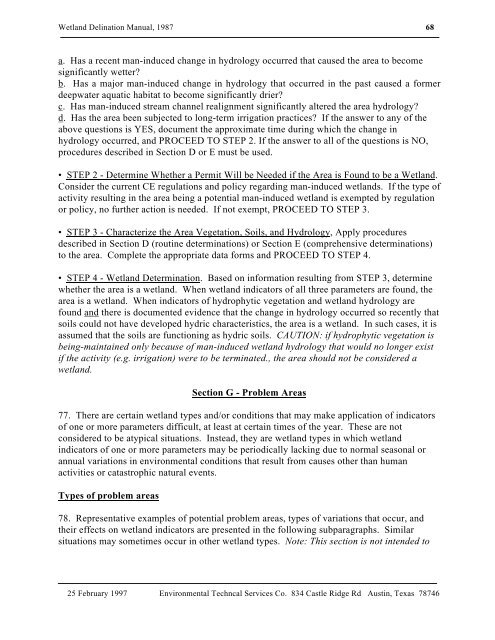1987 Wetland Delineation Manual - The Wetlands Regulation Center
1987 Wetland Delineation Manual - The Wetlands Regulation Center
1987 Wetland Delineation Manual - The Wetlands Regulation Center
You also want an ePaper? Increase the reach of your titles
YUMPU automatically turns print PDFs into web optimized ePapers that Google loves.
<strong>Wetland</strong> Delination <strong>Manual</strong>, <strong>1987</strong> 68<br />
a. Has a recent man-induced change in hydrology occurred that caused the area to become<br />
significantly wetter?<br />
b. Has a major man-induced change in hydrology that occurred in the past caused a former<br />
deepwater aquatic habitat to become significantly drier?<br />
c. Has man-induced stream channel realignment significantly altered the area hydrology?<br />
d. Has the area been subjected to long-term irrigation practices? If the answer to any of the<br />
above questions is YES, document the approximate time during which the change in<br />
hydrology occurred, and PROCEED TO STEP 2. If the answer to all of the questions is NO,<br />
procedures described in Section D or E must be used.<br />
• STEP 2 - Determine Whether a Permit Will be Needed if the Area is Found to be a <strong>Wetland</strong>.<br />
Consider the current CE regulations and policy regarding man-induced wetlands. If the type of<br />
activity resulting in the area being a potential man-induced wetland is exempted by regulation<br />
or policy, no further action is needed. If not exempt, PROCEED TO STEP 3.<br />
• STEP 3 - Characterize the Area Vegetation, Soils, and Hydrology, Apply procedures<br />
described in Section D (routine determinations) or Section E (comprehensive determinations)<br />
to the area. Complete the appropriate data forms and PROCEED TO STEP 4.<br />
• STEP 4 - <strong>Wetland</strong> Determination. Based on information resulting from STEP 3, determine<br />
whether the area is a wetland. When wetland indicators of all three parameters are found, the<br />
area is a wetland. When indicators of hydrophytic vegetation and wetland hydrology are<br />
found and there is documented evidence that the change in hydrology occurred so recently that<br />
soils could not have developed hydric characteristics, the area is a wetland. In such cases, it is<br />
assumed that the soils are functioning as hydric soils. CAUTION: if hydrophytic vegetation is<br />
being-maintained only because of man-induced wetland hydrology that would no longer exist<br />
if the activity (e.g. irrigation) were to be terminated., the area should not be considered a<br />
wetland.<br />
Section G - Problem Areas<br />
77. <strong>The</strong>re are certain wetland types and/or conditions that may make application of indicators<br />
of one or more parameters difficult, at least at certain times of the year. <strong>The</strong>se are not<br />
considered to be atypical situations. Instead, they are wetland types in which wetland<br />
indicators of one or more parameters may be periodically lacking due to normal seasonal or<br />
annual variations in environmental conditions that result from causes other than human<br />
activities or catastrophic natural events.<br />
Types of problem areas<br />
78. Representative examples of potential problem areas, types of variations that occur, and<br />
their effects on wetland indicators are presented in the following subparagraphs. Similar<br />
situations may sometimes occur in other wetland types. Note: This section is not intended to<br />
25 February 1997 Environmental Techncal Services Co. 834 Castle Ridge Rd Austin, Texas 78746


